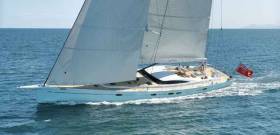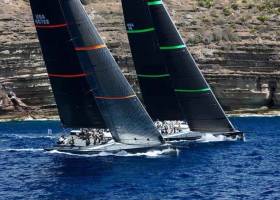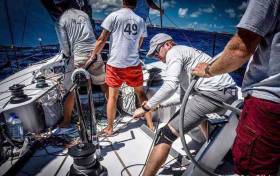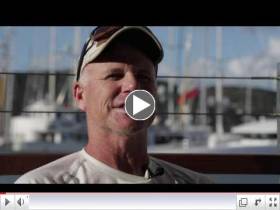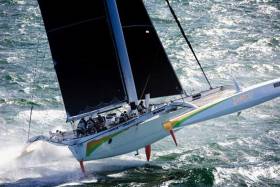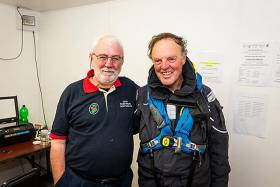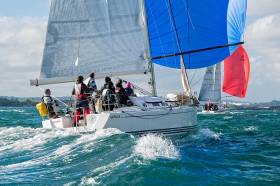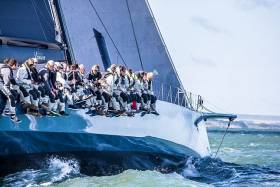Displaying items by tag: Royal Ocean Racing Club
Irish Sailors Still Well Up in RORC Caribbean 600 Mix
Maybe it’s because the weather has been unseasonably like home at times out in the Caribbean, but the Irish sailors spread through the RORC fleet have been in the racing frame through a wet cold front from the nor’west. For a while, it turned sunshine hopes upside down, but the Micks in the mix are on boats which have been showing mighty well since last’s night’s posting, when top navigator Ian Moore on Bella Mente was leading the fleet on IRC writes W M Nixon.
The first of the multi-hulls, Lloyd Thornburg’s MOD 70 Phaedo 3 with Damian Foxall on the strength, has already taken line honours in 33 hours. But further down the line, the pendulum of fortune has swung back and forth as monohull boats of hugely varying sizes take on the challenges of a real cat’s cradle of a course.
The vagaries of fortune are revealed by the fact that for some hours this morning Irish time, the overall leader was the superyacht Dannesskjold, whose crew include Tim Goodbody, Aine Hanevy, and Paul O’Donoghue, while the Kinsale-registered Lilla was third. But the most recent set of figures show that Dannesskjold has plunged to 32nd overall, while Lilla plunhed to 48th, and the best-placed Irish sailor is now Marcus Spillane, originally of Cork, now San Francisco-based, an ISA Board Member and representative on World Sailing.
He also presides over the 49er International Association and the Nacra 17 Association, but currently his focus is on getting the best performance out of the Swan 66 Bounty in the Caribbean 600, and they lie third overall, 20 minutes or so ahead of George David’s Rambler 88 in fourth, and 45 minutes ahead of Bella Mente in 5th. Yet while Phaedo may be well finished, but there’ll be many twists of failure and fortune before we get the final IRC placings.
Mighty Ian Moore Leads RORC's Caribbean 600 Fleet
Afloat.ie “Sailor of the Month” for October 2016, ace navigator Ian Moore originally from Carrickfergus, is once again calling the shots aboard Hap Fauth’s Maxi 72 Bella Mente. And they’re leading the fleet in the RORC Caribbean 600 by nearly an hour on corrected time as the first 24 hours of racing draws to a close with many islands still to be rounded, and a myriad of wind changes to be negotiated writes W M Nixon.
2016 was Moore’s dream year, as among other achievements he piloted the RP 63 Lucky to a runaway win in the Transatlantic Race in July, and then he transferred to Bella Mente for Cowes Week in August and showed he was equally adept at working the inshore Solent conditions to take just about every major prize. Came October, and he guided the Cookson 50 Mascalzone Latino to the overall win in the Middle Sea Race.
Now he’s back at the screens aboard Bella Mente, and has clearly taken over where he left off, on top form. He would have been in there on Bella Mente’s start, which was a classic, calling for water right in under the cliffs as she forced the fleet - and particularly the 2016 winner Proteus – to allow her to tack onto port.
But this is one complex race, like sailing a course made from a bowl of spaghetti, so a lot of chips (if you’ll excuse a hyper-mixing of metaphors) have to fall the right way into the deep-fat fryer which is Caribbean racing, in order to stay ahead of a hungry fleet including the likes of George David’s Rambler 88.
Despite the sad sudden departure of Sean McCarter from the fray aboard the much-fancied Infiniti 46 Maverick after a crewman sustained a serious hand injury, Irish interest is strong throughout the fleet, and the one boat with an Irish sail number, Simon and Nancy DiPietro’s Kinsale YC-registered Briand 76 Lilla (a prize winner in past races), is tramping along in the top half of the fleet, well-placed for a boat which is really a cruiser-racer.
 Lilla is flying the flag for Ireland, and doing mighty well for a boat with full cruising comfort.
Lilla is flying the flag for Ireland, and doing mighty well for a boat with full cruising comfort.
Through the fleet we find such Irish luminaries as Tom McWilliam aboard Leopard, Gabrielle MacManus on Olympia’s Tigress, Wicklow’s David “Farmer” Ryan and WSC Commodorial spouse Jim Cummins on the First 40 Arthur Logic, Damian Foxall on Phaedo 3, Marcus Spillane on Bounty, Barry Hurley and James Murphy on Pata Negra, Maurice “Prof” O’Connell and Dwayne Lysaght on Louise, Timothy Goodbody, Aine Hanevy and Paul O’Donoghue on Danneskjold, Cian O’Carroll on Eleonara E, William Byrne and Chris Raymond on Spice, Mark Norman on Piccolo, Storme Delaney (I’m not making these names up) and Ciara Scott on Sunset, and James Carroll on Spice.
Between them all, we should have something to show for everyone’s efforts in a race which at its inauguration in 2009 was won overall by Adrian Lee’s Cookson 50 Lee Overlay Partners of the Royal St George YC. This is a boat which in a previous incarnation was Ger O’Rourke’s Cheftain of the Royal Western of Ireland yacht Club, overall winner of the 2007 Fastnet. Our 2017 squad have a lot to live up to.
Sean McCarter's Maverick Out of RORC Caribbean 600, Foxall & Green Dragon Are Front Runners
Sean McCarter, the Derry Clipper World race sailor who is part of the Infniti 46 Maverick crew has retired from the RORC Caribbean 600 following an injury to a crewman this morning.
A statement from the boat an hour ago said: "Maverick diverted to Nevis to drop Steve Taylor off at the hospital after suffering an injury to his right hand. As soon as the incident occurred the team retired from the race and made best speed to Nevis. Piers has gone with Steve to the hospital in Nevis. The rest of the team are safe and well. We are on a mooring outside of Charlestown Nevis and will clear customs tomorrow morning. Our thoughts are with Steve. His next of kin have been notified."
McCarter, who has his eye on a Vendee Globe 2020 campaign, was part of the British Maverick crew skippered by Oliver Cotterell.
The latest news from the race tracker is that Ireland's former Green Dragon VOR entry is second overall and while Round Ireland Multhull record holder Phaedo 3 is first multihull they are behind last year's record pace.
An array of Irish sailors are on different boats at this week's event and are lead by County Kerry's Damian Foxall as they compete in the ninth edition of the regatta that started in magnificent conditions with the largest ever offshore fleet assembled in the Caribbean enjoying sparkling conditions. A south–easterly breeze, occasionally gusting up to 15 knots and a relatively calm sea state provided conditions for the perfect start with some close battles on the water yesterday.
Unlike 2016, when two Irish boats were racing, namely; Conor Fogerty's BAM from Howth Yacht Club and the Royal St. George's Lee Overlay Partners Cookson 50 skippered by Adrian Lee this year the sole Kinsale cruiser, Lilla, bears Irish sail numbers.
Navigator Ian Moore originally from Carrickfergus, is once again calling the shots aboard Hap Fauth’s Maxi 72 Bella Mente. David Ryan and Jim Cummins of Wicklow Sailing Club are on UK yacht First 40 Arthur Logic. Maurice 'Prof' O'Connell from the Royal St. George YC is racing and Royal Irish Yacht Club member Storme Delaney, who completed the ARC Rally in December, is also in action. For more Irish sailors on the race please read our update here.
RORC Commodore, Michael Boyd of the Royal Irish Yacht Club in Dublin was hoping to compete on Giles Redpath's Pata Negra, but due to business commitments had to watch the start from ashore this year. "It was almost as nerve racking to be up at Fort Charlotte as on the water, and of course we are all hurlers from the ditch telling them to get closer to the cliffs. It was a fascinating start from an amazing and historic vantage point to see these wonderful boats take off. Everything went very smoothly, which is a great tribute to our professional race management team and our volunteers. This was quite an emotional moment for me and we will of course be wishing them all well for the next few days and a safe return."
The MOD70 battle for multihull line honours has already kicked off. Lloyd Thornburg's Phaedo3 pulled away (with Foxall onboard) from Giovanni Soldini's Maserati at the upwind start but as the two cracked sheets at Green Island, Maserati deployed their foil and took up the lead. Two hours into the race, the two flying trimarans were approaching the Barbuda mark touching 18 knots of boat speed.
George David's Rambler 88 got away to a terrific start and leads the monohull fleet on the water by almost three miles on approach to Barbuda. However, three hours into the race and after IRC time correction, George Sakellaris' Proteus is estimated to be leading overall with Hap Fauth's Bella Mente second and Rambler 88 third.
IRC Canting Keel and IRC Zero produced a thrilling start. Lionel Pean's French Volvo 70 SFS II came charging in on port, baring away behind the two Maxi72s to take a commanding position on the favoured left side of the course.
The Class40 Division are enjoying incredibly close racing. Peter Harding's Ph-orty leads, Catherine Pourre's Earendil and Halvard Mabire's Campagne de France are both within one mile. The pack of Class40s have the magnificent sight of the 182ft twin-masted schooner Adela ahead of them. Cressida Robinson reporting from Carl Wilcox's Nisida: "We have had everything from 15 knots gusting up to 30 and spotted a water spout on the way to Barbuda."
Record RORC Caribbean 600 Fleet Ready for Action (Video)
A record fleet of 80 yachts will be competing in the 9th edition of the RORC Caribbean 600 starting from Antigua this morning.
This year's race will see the most spectacular line-up of high performance boats and crews racing from 30 different countries.
The crew list reads like the 'Who's Who' of international sailors with hundreds of round the world, America's Cup, Olympic and Volvo Ocean Race professionals rubbing shoulders with passionate corinthian sailors on the same 600 mile race course around 11 Caribbean islands.
Check out the pre–event video below with an interview with RORC Commodore Michael Boyd of Dublin Bay.
Round Ireland Record Holders Compete in RORC Caribbean 600
Both monohull and multihull Round Ireland record holders are part of a fleet of over 80 yachts expected for the ninth edition of the 2017 RORC Caribbean 600 in which 900 sailors from 30 different nations will race non-stop around 11 Caribbean islands, starting and finishing in Antigua.
Passionate corinthians will be rubbing shoulders with Olympic medallists, America's Cup winners and round the world sailors in a race to take home the coveted RORC Caribbean 600 Trophy. The 600 mile course is designed to offer a tactical, high speed race with stunning vistas at every corner.
"The RORC Caribbean 600 is very different to the other 600 mile races and definitely not a holiday race in the Caribbean," commented RORC Racing Manager, Nick Elliott. "The race has many tactical legs with land effects and wind-driven currents which are both difficult to predict. The heat of the day and the long nights are also unusual features for an offshore race making it every bit as challenging as the Rolex Fastnet Race, and just as exciting. It is interesting to note that the records for the Rolex Fastnet Race and the RORC Caribbean 600 are very similar."
Featuring a magnificent collection of yachts, an incredibly varied fleet will be racing under the IRC, CSA and MOCRA rating systems, as well as Class40s racing under class rules. Rambler 88, Phaedo3 and Maserati will be gunning for course records, however, the winner of the RORC Caribbean 600 Trophy will be decided by the yacht with the best corrected time under IRC.
George David's American Maxi Rambler 88 is back with an impressive crew line-up for another tilt at the race record, the overall win and class honours. New Zealand's multiple America's Cup winner, Brad Butterworth is part of an impressive afterguard including fellow Kiwi, Brad Jackson and Australian navigator, Andrew Cape. Virtually the entire crew are America's Cup winners and stars of the Volvo Ocean Race.
Phaedo3 has assembled a phenomenal crew for the race and multiple world record holder, Brian Thompson is joined by Volvo Ocean Race winners Robert Greenhalgh and Damian Foxall. Extreme 40 champion, Pete Cumming and the formidable talent of Michel Desjoyeux, the only sailor to have won the Vendée Globe twice. Maserati's skipper, Giovanni Soldini is Italy's most decorated offshore sailor and Maserati has been fitted with foils which can provide a speed advantage over Phaedo3. A fascinating contest for multihull line honours is expected.
The winner of the Multihull Class will be the yacht with the best corrected time under MOCRA. Seven teams are entered including Shaun Carroll's Australian Modified Sea Cart 30, Morticia which is the smallest yacht competing in the entire fleet, and the head-turning all-carbon R-Six, skippered by Robert Janecki, which is the first ever entry from Belize.
IRC Overall for the RORC Caribbean 600 Trophy
Overall winners of the previous eight editions of the race have all come from IRC Canting Keel and IRC Zero. Amongst this year's favourites are two Maxi 72s: Hap Fauth's Bella Mente - overall winner in the 2015 race, and current holder of the RORC Caribbean 600 Trophy, George Sakellaris' Proteus.
Whilst the two Maxi 72s are firm favourites, the stellar cast racing in IRC Canting Keel and IRC Zero includes; Farr 100 Leopard and three Volvo 70s, Lionel Pean's SFS II from France, Trifork skippered by Dutchman Bouwe Bekking and Green Dragon, skippered by Austrian Johannes Schwarz. The dark horse of the canting keel class is Maverick, skippered by Oliver Cotterell. The Infiniti 46 with DSS side foils was class winner for the RORC Transatlantic Race and the Rolex Middle Sea Race.
In IRC Zero, the 182ft schooner Adela, skippered by Greg Perkins is the largest yacht taking part and making a RORC Caribbean 600 debut is Anders Nordquist's Shamanna. The 115ft superyacht is the largest of nine Swans competing this year and boasts a crew including many of Malta's best sailors from the Calascione, Podesta and Ripard families. RORC Admiral and IMA Secretary General, Andrew McIrvine is a guest aboard Grant Gordon's Maxi cruiser 72, Louise. Overall winner of the 2017 Cape to Rio Race, Stefan Jentzsch's German Carkeek 47, Black Pearl is the smallest yacht in IRC Zero. South African America's Cup sailors, Mark Sadler and Marc Lagesse form the afterguard.
With 17 yachts, the largest class competing this year is IRC One and a huge variety of yachts includes Giles Redpath's Lombard 46, Pata Negra, with RORC Commodore, Michael Boyd among the crew. Bernie Evan Wong's RP37, Taz will be proudly flying the Antiguan flag once again. Bernie is the life and soul of the race having competed in all nine editions as skipper.
The IRC Two champion, Ross Applebey's Scarlet Oyster is back attempting to win the class for the fourth consecutive race in a highly competitive field including; Ed Fishwick's Redshift on El Ocaso with a young, top-class crew including, 2012 Olympic Silver Medallist Luke Patience and Figaro sailors, Alan Roberts and Nick Cherry, as well as Volvo Ocean Race sailor, Nick Bubb.
Close racing is expected in IRC Three among four vintage Swans, including two Sparkman & Stephens designed Swan 48s, Jonty Layfield's Sleeper X and Andrew & Mia Schell's Isbjorn. Peter Hopps, skipper of the Sigma 38, Sam has competed in every edition of the RORC Caribbean 600.
Short-Handed Challengers
A number of young talented Figaro teams are expected from Guadeloupe and James Heald's British Swan 45 Nemesis will be racing Two-Handed. Five Class 40s will be competing including Halvard Mabire and Miranda Merron's Campagne de France which won the Class40 division in the 2016 RORC Transatlantic Race, Catherine Pourre's Eärendil, Peter Harding's Phor-ty, Mikael Ryking's Talanta and Marc Lepesqueux's Saint-Pierre & Miquelon.
Ireland’s Michael Boyd Leads RORC in Season of Outstanding Success
Michael Boyd of the Royal Irish Yacht Club is in the midst of a long, interesting and successful sailing career in which he first came to international prominence with the overall win in the 1996 Round Ireland Race on the J/35 Big Ears writes W M Nixon.
With the energy of ten men and widespread international business interests, he was the ideal and popular choice when he became Commodore of the Royal Ocean Racing Club in London on December 4th 2014, and the two years since have been outstanding for the club, with the Commodore setting a prodigious pace both afloat and ashore.
 The Michael Boyd-skippered First 44.7 Lisa on her way to third overall, and best-placed Irish boat, in the Volvo Round Ireland race 2016. Lisa has since gone on to become RORC IRC Overall Points Champion 2016. Photo Afloat.ie
The Michael Boyd-skippered First 44.7 Lisa on her way to third overall, and best-placed Irish boat, in the Volvo Round Ireland race 2016. Lisa has since gone on to become RORC IRC Overall Points Champion 2016. Photo Afloat.ie
This has been supported by having the hugely-experienced sailor and administrator Eddie Warden-Owen as the RORC’s Chief Executive Officer. The irony of it is that while Michael Boyd cut his sailing teeth in Dun Laoghaire where his father was a noted owner-skipper in the Dublin Bay 21 class, Warden-Owen learned his skills across channel just 54 miles away in Holyhead racing GP14s to international level, and at nearby Trearddur Bay sailing the local Seabird Half Raters.
Thus it’s a direct Irish Sea cross-channel linkup which is giving the RORC its current buzz, and the synergy and shared enthusiasm between these two dynamic people has seen the RORC moving on to greater achievement during the past two years, with the publication yesterday evening of the season’s overall Points Championship reinforcing the image of an international organization on top of its game.
 Eddie Warden Owen, CEO of the RORC
Eddie Warden Owen, CEO of the RORC
The RORC Season's Points Championship 2016 is the largest and arguably most competitive offshore yacht series in the world. Starting almost a year ago with the RORC Transatlantic Race, it consisted of 14 races where over 300 yachts from 15 different nations raced over 6,500 miles. The modern version of the championship is far from domestic as it includes the RORC Transatlantic Race, RORC Caribbean 600, Volvo Round Ireland Race, the brand new Ile d'Ouessant Race, and Rolex Middle Sea Race.
Irish interest naturally focused most directly on the Volvo Round Ireland Race in June, but we also had close links to the RORC Caribbbean 600 in February and the Rolex Middle Sea Race in October, with Conor Fogerty’s Sunfast 3600 Bam! from Howth winning Class 3 in the Caribbean (which has since helped her to place third overall in class in the points championship) while the Middle Sea race saw Carrickfergus’s Ian Moore navigate the Cookson 50 Mascalzone Latino to a very clearcut overall win.
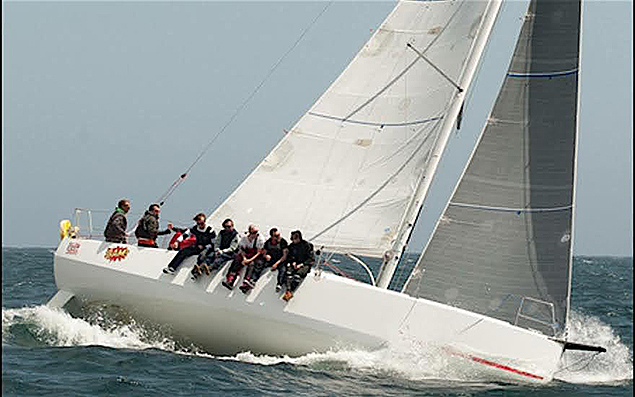 Conor Fogerty’s Bam! has placed third overall in the RORC IRC 3 Championship
Conor Fogerty’s Bam! has placed third overall in the RORC IRC 3 Championship
But with the Volvo Round Ireland in June, it was the RORC Commodore himself who set the Irish pace, as he campaigned the first two-thirds of the season in partnership with Nick & Suzi Jones on the First 44.7 Suzi while he awaited delivery of his JPK 10.80 Audrey (named after his late mother). Racing Lisa in the Round Ireland, Michael Boyd gave a master-class in showing how to get the best out of a standard production boat when set up against some very special machines, and his third overall not only made him top Irish boat overall, but also contributed a mighty heap of points to help Lisa become the RORC IRC Overall Champion 2016. This is a prodigious achievement, as the other points were accumulated in steady, frequent and successful participation in the RORC’s regular programme of shorter events manageable within a long weekend.
This overall win and the IRC I win means that the Lisa team will, be leaving the awards ceremony in London on Saturday November 19th with a mountain of silverware, while another boat prominent in the prize stakes will be the IMOCA 60 Artemis Ocean Racing, overall points winner of IRC Canting Keel, which has been skippered through 2016 by Mikey Ferguson, who originally hails from Bangor in County Down, and has risen steadily through the ranks in the Artemis Academy.
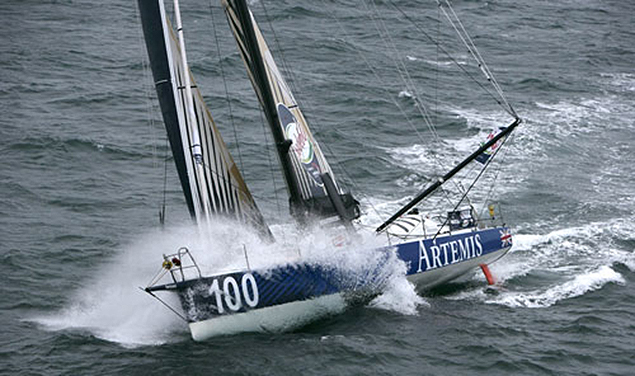 The IMOCA 60 Artemis, skippered by Mikey Ferguson of Bangor to overall win in the RORC Canting Keel Class Championship.
The IMOCA 60 Artemis, skippered by Mikey Ferguson of Bangor to overall win in the RORC Canting Keel Class Championship.
And while we’re on the more extreme machines, another special award on Saturday November 19th will go to Lloyd Thornburg’s MOD 70 Phaedo 3 from America, overall winner of the Multi-hull Class and also winner of the Beken Trophy for Concours d’Elegance. We got to know Phaedo 3 very well in Ireland, as she took second in the MOD 70s in the Volvo Round Ireland, and found the Irish course such an attractive challenge that she was back in July to have another go at the new record which had been set by Oman Sailing in the Volvo Round Ireland race, and succeeded in shaving it by upwards of an hour or so.
However, with all fairness to the many star boats in the RORC season which graced our waters at some time or another, there’s no doubting that the people’s choice was Eric de Turckheim’s unusual-looking but extraordinarily attractive A13 Teasing Machine from France, which spent quite a while here as she did the Volvo Round Ireland and then went down to Crosshaven for Volvo Cork Week, through which she cut a mighty swathe.
For those of us who found teasing Machine irresistible, the great news is that she has been declared RORC Yacht of the Year for 2016. The citation says it all:
RORC Yacht of the Year: Teasing Machine, A13, Eric de Turckheim (FRA)
Somerset Memorial Trophy: Awarded for outstanding racing achievement by a yacht owned or sailed by a RORC member as voted for by the RORC Committee.
It's been an incredible year in distance travelled and success for Eric de Turckheim's French A13, Teasing Machine. After crossing the line in 11th place and a class win at the Rolex Sydney Hobart Yacht Race, the boat was shipped to Panama before being sailed 1,200 miles upwind to Antigua to be on the startline for the RORC Caribbean 600 in February. Another great achievement as the team clinched a class win in IRC One and finished third overall, only being beaten by two Maxi 72s. Teasing Machine was then shipped back across the Atlantic to compete in the Volvo Round Ireland Yacht Race for yet another class win and finishing second overall to an unbeatable Rambler 88. Following the IRC Europeans at Cork Week, it was on to Cowes to help secure a French victory in the biennial Brewin Dolphin Commodores' Cup in July, before an overall win in the inaugural Ile de Ouessant Race. This incredible season finished with another class win in the Rolex Middle Sea Race last month.
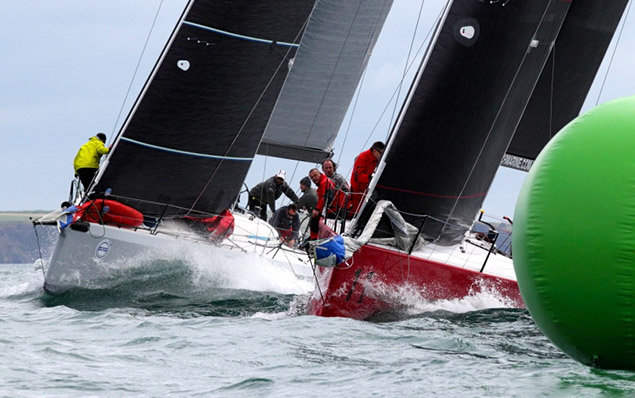 Neck and neck. Eric de Turckheim’s A13 Teasing Machine comes to the weather mark with Anthony O’Leary’s Ker 40 Antix during Volvo Cork Week 2016. Teasing Machine has been declared RORC Yacht of the Year 2016. Photo courtesy Volvo Cork Week/Tim Wright
Neck and neck. Eric de Turckheim’s A13 Teasing Machine comes to the weather mark with Anthony O’Leary’s Ker 40 Antix during Volvo Cork Week 2016. Teasing Machine has been declared RORC Yacht of the Year 2016. Photo courtesy Volvo Cork Week/Tim Wright
Class winners for the 2016 RORC Season's Points Championship
IRC Canting Keel: IMOCA 60 Artemis Ocean Racing, Mikey Ferguson
IRZ Zero: Ker 46 Shakti, co-skippered by Christoph Avenarius and Gorm Gondesen
IRC One: First 44.7 Lisa, Nick & Suzi Jones
IRC Two: J/133 Pintia, Gilles Fournier
IRC Three: JPK 10.10 Raging Bee, Louis-Marie Dussere
IRC Four: JPK 10.10 Foggy Dew, Noel Racine
IRC Two Handed: JPK 10.10 Raging Bee, Louis-Marie Dussere
Multihull Class: MOD70 Phaedo³, Lloyd Thornburg
Class40: Concise 2, owned by Tony Lawson
ICRA Attends IRC Annual Congress That Attracts Global Interest
Ireland's Mark Mills, the Irish Cruiser Racer Representative (ICRA), was among forty delegates from 15 countries descended upon Cowes, Isle of Wight, the home of yachting in the UK, for the annual Congress of the Spinlock International Rating Certificate (IRC) Owners' Association. The weekend was hosted by the RORC Rating Office at the RORC Cowes Clubhouse and the Royal Yacht Squadron, with representatives travelling from all over the world including Australia, the USA, Europe, Japan and SE Asia. Discussions varied from technical aspects of the IRC Rule, which is jointly owned by RORC in the UK and UNCL in France, to race management, measurement, and certificate administration.
Technical Developments for 2017
Simplifying the rating of aft rigging
As racing yacht design becomes more complex and varied, the ethos of IRC is to keep the Rule as simple as possible, protect the existing fleet and try as much as possible to control costs. With this in mind one notable change for 2017 will be a development in the treatment of aft rigging. In recent years it has become apparent that the established definitions for backstays, running backstays and checkstays do not suit all types of modern rigging arrangements. For 2017 IRC will not distinguish between these different types but will count the total number of aft rigging stays, which will simplify the application process for owners.
Addressing undesirable trends
A second change for 2017 reflects the recent trend of moving lead from the bulb into the fin. The IRC Technical Committee does not consider this trend to be healthy for the sport, so in future will be asking for a declaration of the amount of lead in the keel fin for certain types of keel. Members of Congress agreed with both these changes which will come into force on January 1st 2017.
The 2017 Irish IRC championships, raced as part of the ICRA National Championships, will be held next June in Cork Harbour. As previously reported by Afloat.ie, the event is chaired by Paul Tingle of Royal Cork Yacht Club.
More details of the above mentioned technical changes, and the IRC 2017 Rule text and Definitions here
Leopard Out to Break Monohull RORC Transatlantic Record
Racing across the Atlantic evokes the primal desires of any offshore sailor and the Grenada-bound RORC Transatlantic Race, departing from Calero Marinas Marina Arrecife, Lanzarote on Saturday 26th November, has attracted a highly diverse range of boats and crews to compete in the third edition.
Whilst the Atlantic is only half the size of the Pacific, Mid-Atlantic is as far away from land as possible, save Point Nemo in the depths of the Southern Ocean and Mike Slade's 100ft canting keel maxi, Leopard 3 is no stranger to the Atlantic. Leopard has accomplished five separate Transatlantic records over the last nine years and has crossed the Atlantic 12 times, with this race being Boat Captain, Chris Sherlock's 30th crossing. Leopard 3 is very capable of breaking the current monohull record for the RORC Transatlantic Race, set by Jean-Paul Riviere's Finot 100, Nomad IV in the last race in 10 days 07 hours 06 mins 59 secs.
"The RORC record is the one we have not had and we want to add this to our list of achievements," commented Leopard's Chris Sherlock. "We are close to finalising the crew which will include regular Leopard crew with Olympic, Volvo Ocean Race and America's Cup experience as well as eight guests who have a lot of racing experience and a big desire to race across the Atlantic. This combination works really well as it makes for a fantastic atmosphere on board.
"After a highly successful inshore season, winning at the Maxi Worlds and St. Tropez, Leopard is being put into offshore mode for the RORC Transatlantic Race. Transforming Leopard for the race is a big task and Lanzarote has everything we need for the preparation. The installation of all the safety equipment is mandatory and on top of that we have a different sail wardrobe and take spares and the tools to fix just about anything on board. Once we have started the race, the crew is on its own and we have to account for any eventuality. All of our guests are attending a sea survival course which is invaluable as well as a great way for the two groups of friends to bond together."
Maserati, synonymous with Italian flair and style, will be represented in this year's RORC Transatlantic by Giovanni Soldini's foiling MOD70. Maserati will be literally flying off the start line! This will be the first time the multihull in its new foiling set up has raced across the Atlantic, and it is something of a test bed for the international team.
Soldini has over 25 years of ocean racing experience and is probably the most decorated Italian offshore sailor of all time winning the Around Alone, Québec-Saint Malo, OSTAR and Transat Jacques Vabre. Soldini has completed over 40 oceanic crossings and since 2011 has been the skipper of the VOR70 Maserati, setting records for the Cadiz-San Salvador route and the New York-San Francisco Gold Route. However, the MOD70 Maserati is a new project only conceived this year.
"We are studying how this new concept will work and we have made some progress, but we are in research mode." explained Giovanni Soldini. "Our goal will be to try to fly as much as possible, but there are some conditions where it will be impossible. We went around the world nearly two times with the VOR70 but it was time to change and to do something different. Personally for me, this is a bigger challenge and foiling in the middle of the Atlantic is certainly challenging. This race presents a great opportunity to try to understand more about the concept.
"On the tiller, when Maserati is flying, is just fantastic. It is very fast but you feel safe and in control and it is something very new; to fly with a big boat is something that is very special. During the race we will be studying and trying many different solutions to see where our performance is good or not so good, but it is not always black and white. This year we will be investing in the concept for the future. Our first step will be to achieve stable flight in the open sea with waves, so that will be a big job."
Innovative foiling flyer
Infiniti 46 Maverick, skippered by Oliver Cotterell will be one of the smallest yachts in the race, but her innovative design means that Maverick is capable of tremendous speed. DSS foils, like short airplane wings protrude from the side of the hull, producing both righting moment and lift. Maverick also has a canting keel and the combination of these allow the boat to sail faster than the wind speed, in certain conditions.
"I have been watching the RORC Transatlantic Race since its inception. I think it's a brilliant ocean race that's been growing year on year. I have heard great things about its implementation, organisation and the back-up RORC provides for the teams involved," commented Skipper, Oliver Cotterell. "Maverick has been entered for the RORC Transatlantic Race because it is designed for performance racing vessels. Just looking at the entries and the interest so far shows that this is a serious race with some serious teams. We want to compete against high performance elite racing yachts and the best teams on the circuit.
"The speeds we are maintaining whilst foiling on Maverick are unprecedented for a 46ft monohull, but it is actually a very stable feeling. The DSS foils mean she not only stays flat, but she also lifts her bow so that as we navigate through Atlantic swells, the boat should remain surprisingly dry. Maverick was always designed with long distance competitive offshore racing in mind. Preparation for CAT.1 racing was incorporated in the design from the very beginning. The boat has watertight bulkheads and has been built with the required inventory since her inception."
France Blue Continues to Lead Commodore's Cup
Despite three more inshore races being held on day five of the Brewin Dolphin Commodores' Cup, the Royal Ocean Racing Club's biennial flagship event for three boat teams with Corinthian crews, France Blue leads with a similar 11.5 point margin to yesterday, but Flanders North Sea is now the team that has relieved France White of second place overall.
Today racing returned to the central-eastern Solent with two windward-leeward races and one round the cans course. The day started in July-like sunshine and a light southwesterly, but the arrival of an occluding front early afternoon brought cloud, light rain and an ultra-shifty breeze and fog thick enough to make spotting marks hard - more October-like conditions.
The first race saw a pair of wins for GBR Red: The Henning family's Mumm 36, Alice, won in Class 1 and the J/35, Bengal Magic, claimed the small boat race - the first bullets for both boats.
For Alice, it was well timed. This was after a recent fight with a pontoon in Cork that required intense repair work only completed last Friday, and followed a grounding on the Hampshire shore yesterday and another long night in the shed.
"It hasn't been great this last couple of weeks," admitted Simon Henning. As to today's race win: "The wind was right for us - nice and light on the first beat. We had a good start and went left, where the tide was better."
The lighter, flatter water first race favoured the 20+ year old designs, Bengal Magic skipper James Chalmers agreed: "The wind was a bit lighter and everything just seemed a lot easier. We had to spin around the back because we were over early, but we knew the direction we wanted to go in and give that a push." They too benefitted from hitting the left.
However GBR Red has 184.5 points, just 4.5 away from the podium, but is struggling for consistency. La Réponse's normally immaculate starting left them today - in all three races they were over early. "The team thing is great," continued Chalmers. "You have good days and you have bad days. In the last race, we went the wrong way up the first beat and paid for it. In this event you get punished for the slightest mistake."
Today's top scoring boat was Noel Racine's JPK 1010 Foggy Dew, the 'small' boat in France White with a 5-1-1. Their team mate, the First 40.7, Pen Koent of Emmanuel le Men, is the top scoring 'big' boat, however their performance is offset by Didier Gaudoux's JND 39, Lann Ael 2, which scored three of today's biggest results. Mention should be made of Andrew Hurst's sistership, Stamina, which had her best day finishing third the two final races.
Race two saw a win for GBR Blue's and the Blair family's King 40, Cobra, but they sandwiched this between an 10th and an 8th. Spokesman and mastman, Richard Moxey, described their winning race: "We nailed the start and the first beat, going left. We made smooth manoeuvres, no muck-ups. Then we hoisted and did a quick gybe and had clear wind for the run."
In the Israeli team, placed fifth overall, it was the turn of the JPK 1010, Carlton, Tel Aviv, to perform best, posting a 2-7-5.
Omer Brand, upwind trimmer and Team Israel manager commented: "All in all, I think we are doing well for our first attempt bearing in mind that most of the guys [and girls] have never sailed on these types of boats nor done a serious regatta before. They are loving it and are never giving up."
Once again France Blue was the star performer, but even they are having a mixed set of results, as yacht designer Daniel Andrieu, skipper of their 'small' boat, Cifraline 4, explained: "Yesterday we had a very, very poor day with bad starts, laylines and spinnaker sets - everything was bad. Yesterday night we had a big meeting - we didn't change anything, but we decided how to improve everything. This morning we went out early and did a lot of manoeuvres with spinnakers, gybes, tacks, laylines, etc and after that we were better prepared."
Cifraline's seven crew, five of whom, Andrieu admits, are closer to 70 than 60 years old, also preferred being back in the central eastern Solent, even though conditions were still tricky. "The wind is more shifty. You get a lake of wind and then a shift of 20°. It is great fun!"
Racing continues tomorrow with the traditional race around the Isle of Wight which will score with a 1.5x co-efficient.
The third edition of the Royal Ocean Racing Club's RORC Transatlantic Race will start on Saturday 26 November 2016 and the line-up will include MOD70s and Maxi yachts vying for the prestigious IMA Transatlantic Trophy awarded to the line honours monohull winner. The usual diverse range of highly competitive, experienced offshore RORC racers will also be on the start line. Their focus will be competing for the RORC Transatlantic Race antique silver trophy and the new RORC Caribbean Series Trophy for the best combined result in the RORC Transatlantic Race and 2017 RORC Caribbean 600.
The 2,995 nm RORC Transatlantic Race will be welcomed back to Marina Lanzarote, situated in Arrecife where the 'lunar-like' volcanic mountains provide a spectacular backdrop to the start of the race from the most easterly Canary Island. Race hosts are the well-known Calero family who are no strangers to race boats and major regattas. They have organised a full week of hospitality and parties before the start of the race which will keep the race crews fully entertained.
Grenada welcomes back competitors
The highlight for most crews is the arrival and warm welcome received in Grenada, where Camper & Nicholsons Port Louis Marina will be hosting the fleet once more, along with the continued support of the Grenada Tourism Authority. The beautiful tropical spice island is also famed for its dive sites, including the world's first underwater sculpture gallery at Molinere Bay. The prizegiving will be held on Friday 16th December, giving crews enough time to enjoy everything the island has to offer before Christmas, or to join in the Caribbean regatta season on their way to the RORC Caribbean 600 in February 2017.
Super-Maxis return
Several yachts have expressed their interest in the race and intend to compete in the 2016 edition. Returning for the third consecutive race will be the Southern Wind 90, Windfall and Jean-Paul Riviere's 100ft Finot-Conq, Nomad IV who won IRC overall in the 2015 race, along with the IMA Trophy for monohull line honours. Nomad IV also set a new monohull record for the RORC Transatlantic Race in the same year.
Other notable Maxi's include the largest on the entry list, Peter Harrison's Farr 115ft (35m) ketch, Sojana, and current holder of 5 World Speed Sailing records and 7 course records, Mike Slade's 100ft Farr (30m), Leopard:
"Full congratulations to the RORC for promoting an east to west transatlantic race which has proved a success in the last two years. Leopard is hoping to compete in the event and would be keen to attack the record set last year by Nomad IV of 10 days 07 hours 06 minutes and 59 seconds to add to our other Atlantic records," exclaims Slade.
Multihull battle for line honours
The on-the-water MOD70 battle looks set to continue between Lloyd Thornburg's unstoppable Phaedo3 and Tony Lawson's Concise 10, skippered for the past eight years by 28-year old Ned Collier-Wakefield of Team Concise. Both record-breaking crews have registered their intent to repeat the MOD70 duel after match racing across the Atlantic in last year's race.
Hotting things up is the possibility of Sidney Gavignet's Musandam-Oman Sail joining the race. Oman Sail's flying machine recently claimed multihull line honours, taking over 2 hours off their existing record and setting a new world record for the fastest-ever sail round Ireland in the Volvo Round Ireland Yacht Race - with Phaedo3 and Concise 10 minutes behind them!
Following the recent launch of Giovanni Soldini's newly refitted semi-foiling MOD70, Maserati, the Milanese navigator seems to also have his sights set on smashing records such as the RORC Transatlantic Race in a bid to continue his record breaking campaign. Watch this space, as it will be huge battle by the four MOD 70's for the first to arrive in Grenada.
Diverse fleet
It's not all about super-maxis and trimarans though, as the last two editions of the race have attracted highly competitive boats from the smaller end of the fleet, such as Class40s and several Two Handed teams. This third edition is set to follow in the same mode.
The first boat to enter the 2016 RORC Transatlantic Race was James Heald's Swan 45, Nemesis and he will have good competition from Ossie Stewart's Dufour 45, Island Girl. Veteran Olympic sailing medallist, Stewart last crossed the Atlantic in 2014 with the ARC. This time they are hoping to cross with the RORC Transatlantic Race and have big aspirations of a podium position before taking on another season of racing in the Caribbean. Rónán Ó Siochrú's Sun Fast 37, Desert Star is also hoping to be on the start line and the Principal at Irish Offshore Sailing has a wealth of offshore experience.
Two new boats to watch out for will be the DSS equipped Infinity 46, Maverick and a brand new Marc Lombard designed IRC 46, Pata Negra for Giles Redpath. Redpath is planning a full RORC Offshore Championship season and the 2016 RORC Transatlantic Race will be the first event of his 2017 campaign.

